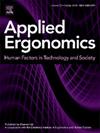放大伽利略系统和工作姿势在牙科学生:交叉研究
IF 3.4
2区 工程技术
Q2 ENGINEERING, INDUSTRIAL
引用次数: 0
摘要
本研究调查了不同倍率的伽利略系统对牙科学生在临床前程序中的姿势的影响。37名牙科大学二年级学生参与了本研究。因变量包括从颈部中性位置的角度偏差,颈部肌肉活动,以及从操作者眼睛到假人嘴的工作距离。自变量为伽利略系统放大镜的四种倍率(裸眼、2.5倍、3.0倍、3.5倍倍率)。学生使用牙齿模型在上颌第一磨牙上进行I级牙齿准备,并在手术过程中记录姿势。“姿态评估软件”(0.69版本)分析了角度偏差和工作距离。用降斜方肌和胸锁乳突肌的表面肌电图评估双侧肌肉活动。进行描述性统计分析和单因素重复测量方差分析(rANOVA) (α = 0.050)。结果,在牙齿准备过程中,肉眼观察到颈部有较大的角度偏差(p <;0.001)。然而,不同的放大倍数对肌肉活动(p = 0.050-0.911)和工作距离(p = 0.136)没有影响。可以得出这样的结论:不管放大率如何,使用伽利略望远镜可以减小角偏差;然而,它不影响肌肉活动或工作距离。本文章由计算机程序翻译,如有差异,请以英文原文为准。
Magnification of the Galilean system and work posture in dental students: a crossover study
This study investigated the effects of different magnifications of the Galilean system on the posture of dental students during pre-clinical procedures. Thirty-seven second-year undergraduate dental students participated in this study. Dependent variables included angular deviation from the neutral position of the neck, neck muscle activity, and working distance from the operator's eyes to the mannequin's mouth. The independent variable was the magnification of the Galilean system loupes at four levels (naked eye, 2.5×, 3.0 × , and 3.5× magnification). Students performed Class I teeth preparations on the maxillary first molar using a dental mannequin, and postures were recorded on photographs during the procedure. The “Software for Postural Assessment” (version 0.69) analyzed the angular deviation and working distance. Muscle activity was assessed bilaterally using surface electromyography of the descending trapezius and sternocleidomastoid muscles. Descriptive statistical analysis and one-way repeated-measures analysis of variance (rANOVA) was conducted (α = 0.050). As a result, a greater angular deviation of the neck was observed with the naked eye during tooth preparation (p < 0.001). However, different magnifications did not affect the muscle activity (p = 0.050–0.911) or working distance (p = 0.136). It was possible to conclude that, regardless of the magnification, using Galilean loupes reduced angular deviation; however, it did not influence muscle activity or working distance.
求助全文
通过发布文献求助,成功后即可免费获取论文全文。
去求助
来源期刊

Applied Ergonomics
工程技术-工程:工业
CiteScore
7.50
自引率
9.40%
发文量
248
审稿时长
53 days
期刊介绍:
Applied Ergonomics is aimed at ergonomists and all those interested in applying ergonomics/human factors in the design, planning and management of technical and social systems at work or leisure. Readership is truly international with subscribers in over 50 countries. Professionals for whom Applied Ergonomics is of interest include: ergonomists, designers, industrial engineers, health and safety specialists, systems engineers, design engineers, organizational psychologists, occupational health specialists and human-computer interaction specialists.
 求助内容:
求助内容: 应助结果提醒方式:
应助结果提醒方式:


